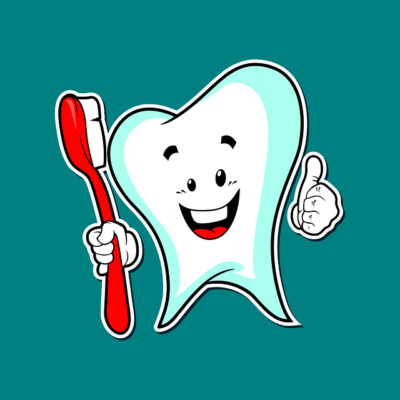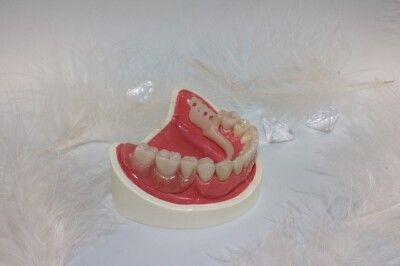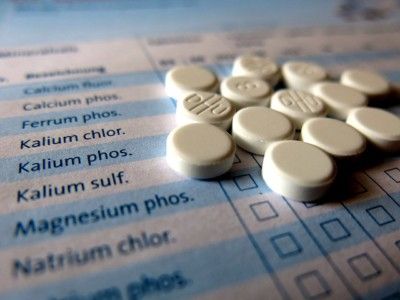Back to nature – Dental care with dental chalks
It has been known for a long time that it is certain bacteria that cause tooth decay and periodontal disease. The principle: They convert the sugar from food into organic acids, which then demineralize the tooth, creating holes. Caries is born.
Other strains of bacteria are more likely to cause inflammation, which leads to recession of the gums and degradation of the jawbone; this is then called gingivitis and periodontosis.
It is also known that this process of demineralization starts at a pH value of 5.5. That is why – in a way – fluoridation also works, because the fluoride crystals in the teeth provide a (slightly) stronger acid protection, which reaches a pH value of 4.6. At the same time, fluorides block important metabolic functions in bacteria, i.e. they have a biocidal effect.
Fluorides are largely stable compounds of the highly toxic element fluorine with other elements or molecules. Similar to table salt, which also contains chlorine, a toxic element. Whether and how toxic or. harmful these substances actually are in the body depends on various factors.
One is the detoxification capacity of the body, which requires a large number of enzymes for this purpose, for the production of which, in turn, all kinds of vitamins, minerals and trace elements are needed, etc..
Therefore, the argument of the general toxicity of certain elements and compounds, which is often found in the natural healing scene, misses the point and causes more confusion than clarification.
Analogous applies to the „warnings“ of the opposite side, for example before chlorine dioxide (MMS) or amygdalin, the anti-cancer active substance in bitter apricot kernels.
Fluorides in toothpaste, in salt and in drinking water are therefore actually not harmful to health because the element fluorine is contained, but because these fluorides are able to block a number of enzymes – not only those of bacteria, but also in the human metabolism.
Currently, at least 24 enzymes are known to be disabled by fluorides. However, since the quantities ingested are usually very small, this usually has no direct effect on our health. At least at first, because fluorides are not completely excreted again. A part remains in the body, also because they are just bound by reactions with enzymes and other substances.
A biochemical reaction known since the 1920s is that with thyroxine, the thyroid hormone, where it displaces iodine from the molecular bond. This is why fluorides were used a few decades ago as a drug to treat hyperthyroidism. And that is why, for example, a study published in 1955 also showed a fourfold increase. of the laryngeal cancer rate in San Fransico during the period of drinking water fluoridation.
Even the smallest amounts are enough to affect the hormonal system. According to the English thyroid specialist Dr. According to Barry Durrant-Peatfield, fluorides already have an effect there at a concentration of less than 1 ppm (parts per million).
Assuming the same molecular weight (which is possible as a rough approximation), 15 milligrams in the approximately 15 liters of lymph fluid in the human body are sufficient to trigger hormonal effects – and this is exactly what has been observed.
Not only from this point of view the common doctrine of fluorine resp. Fluoride as an essential trace element more than doubtful. Since no corresponding deficiency symptoms are known either, this thesis is therefore increasingly being called into question.
Remarkably, in the meantime the Federal Institute for Risk Assessment has also moved away from this: „Fluoride is not essential for human life“, it says in the corresponding information sheet from 2005.
Nevertheless, some „experts“ still propagate a daily requirement. This is derived, among other things, from the amount excreted and is said to be in the range of 0.04 mg per kg body weight for adults and 0.06 to 0.08 mg for children, who (are supposed to) need more because of their bone growth – relatively speaking; in absolute terms it would be less.
Thus, a child weighing 20 kg should take in about 1 mg of fluoride a day – an amount that is usually not reached with the normal average diet, which is why fluoridated salt and even fluoride tablets have been developed.
At the same time, the use of this salt in canteens is prohibited, and according to the law, mineral waters with a fluoride content of 1.5 mg/l or more must be labeled accordingly; more than 5 mg/l are not permitted in drinking water either.
This is about the daily amount that is still considered safe for adults from the point of view of orthodox medicine; above 10 mg per day is already considered problematic in the long term. So even the „official“ safety window is quite small.
It becomes even much smaller if one – as already mentioned above – takes into account that between 15 and 70% of the absorbed amount remains in the body – either in the connective tissue and in the bones, where it combines preferentially with the calcium and thus makes them more brittle (the so-called skeletal fluorosis), or precisely as a reaction partner of enzymes and hormones…
What this can lead to is shown not only by the San Francisco cancer study, but also, for example, by the development of intelligence. The result of the meta-study conducted by the Chinese Nanjing University in 2008 caused quite a stir internationally: 20 years of too much fluoride in drinking water lowers IQ by an average of 7 points. Of course, this does not necessarily mean „Without water filters no Nobel Prize!“
But the finding coincides very well with the fact that fluoride compounds are preferentially used as active ingredients in psychotropic drugs that „dull“the mind.
All this has been known for decades and is also well documented – so well that by the mid-1990s most European states and regional bodies had withdrawn from drinking water fluoridation again. In Germany, it has no longer been practiced since 1993.
But not only the fluoride is dangerous. The next harmful substance contained in almost all conventional toothpastes (and soaps and shampoos) is sodium lauryl sulfate (SLS), often referred to on the packages as sodium lauryl sulfate.
SLS has an inflammatory effect, irritates the skin, burns the eyes, is considered an allergen and, according to research results from Tohoku University in Japan, can even change the genetic material in our cells.
A third (and totzdem not last) „controversial“ ingredient in some toothpastes is the antibiotic triclosan. Since the problem of antibiotics is well known, a quote from the recommendation of the Federal Institute for Risk Assessment is sufficient at this point: „The use of triclosan should be limited to what is absolutely necessary in the medical field.“
Toothpaste to increase the pH level in the oral cavity
With so many potential or real toxins in dental care products, the question arises whether there aren’t other, natural ways to keep our chewing tools healthy or even repair damage. And there are actually.
The strategy is as simple as it is obvious: increasing the pH value in the oral cavity combined with natural antibacterial agents.
This is done, for example, by dental chalk, which combines the alkaline calcium carbonate (chalk) with the wood sugar xylitol and certain herbs and plant components. (see www.dental chalk.de)
The pH value of 8.4 ensures that the environment in the oral cavity does not quickly slip into the critical range below 5.5, even in the case of strong acid attacks. At the same time, the dental chalk promotes the remineralization of the teeth, because for this the saliva must be alkaline.
Xylitol, which most bacteria cannot metabolize, prevents germs from attaching themselves to tissue structures via biochemical mechanisms. This is not only true for the teeth, but z.B. also for the nasal mucosa and auditory canals.
Homeopathy also knows that dental chalk is a great dental care product. The remedies of choice for a high caries tendency are Calcium fluoratum and Calcium phosphoricum.
Conclusion: Effective natural and therefore safe dental care is possible. Here too: back to nature – with dental chalk!









